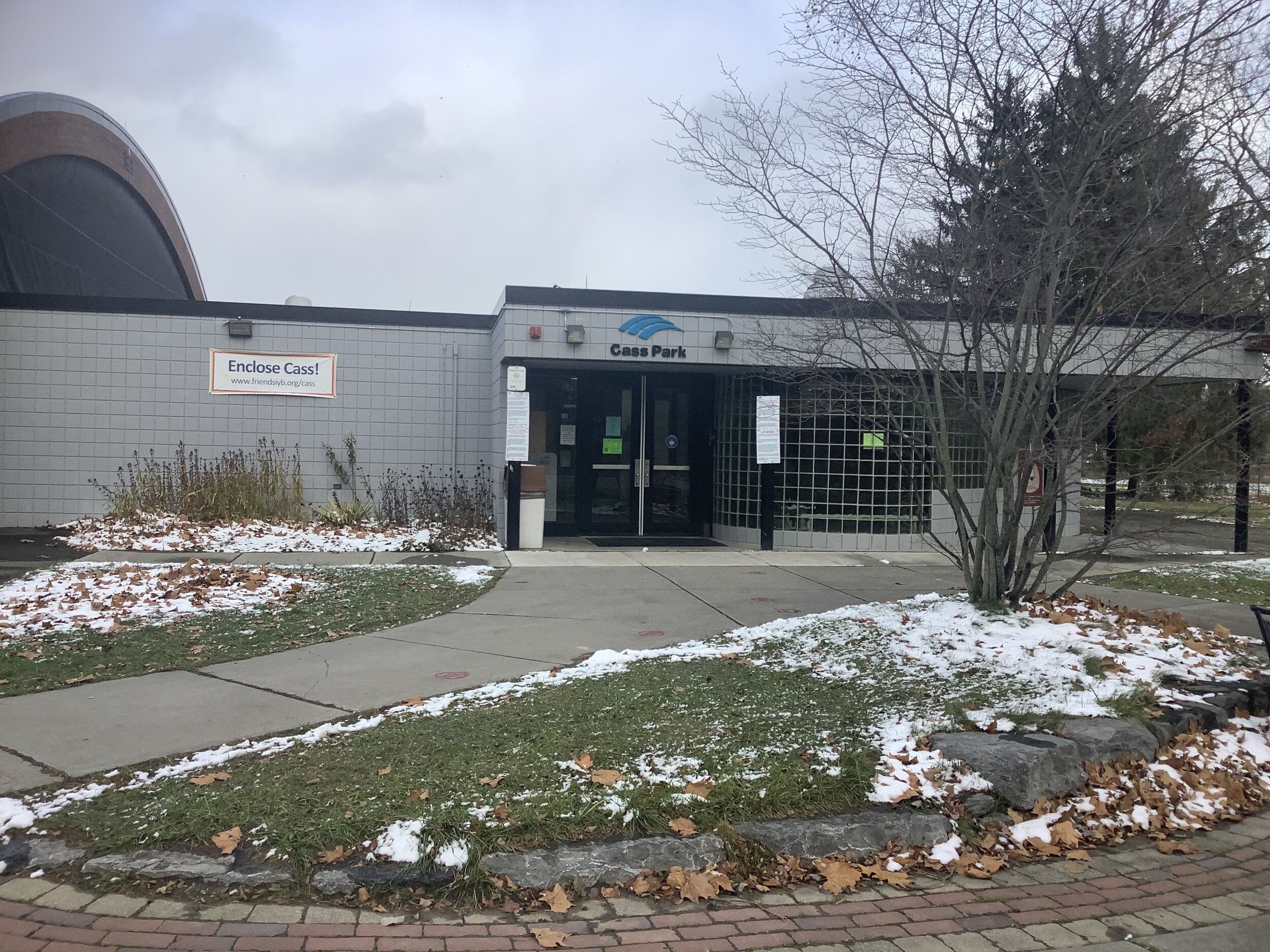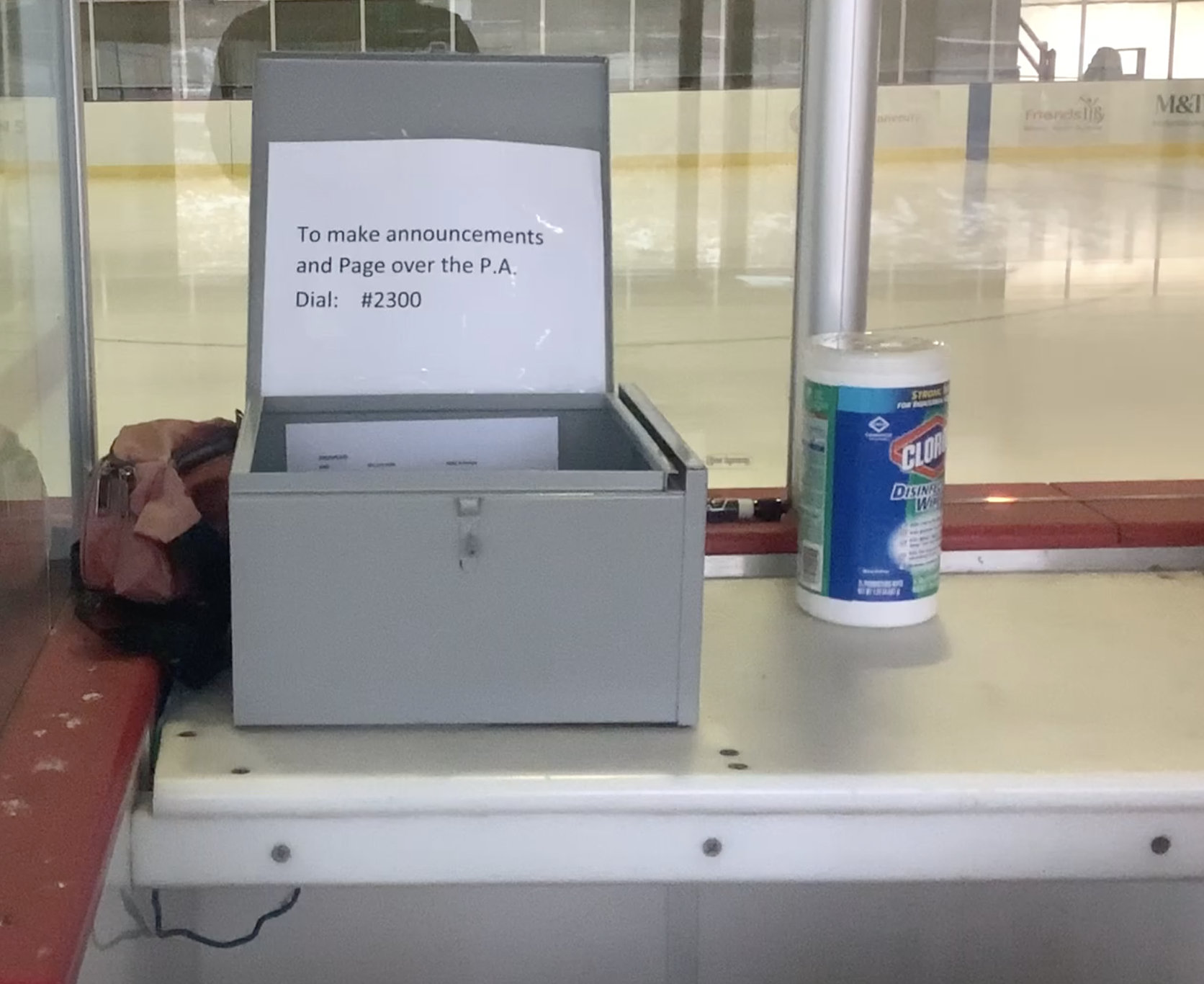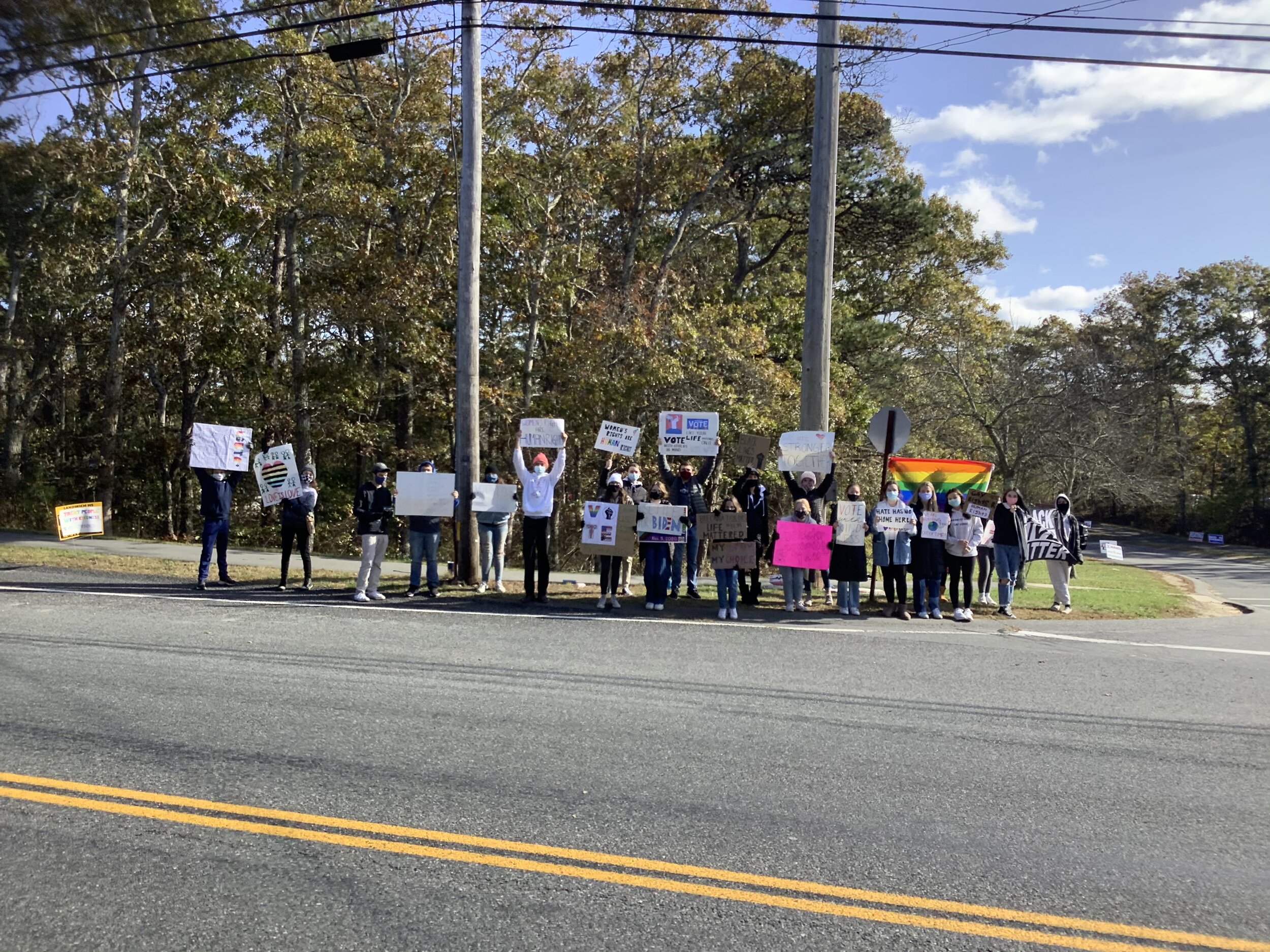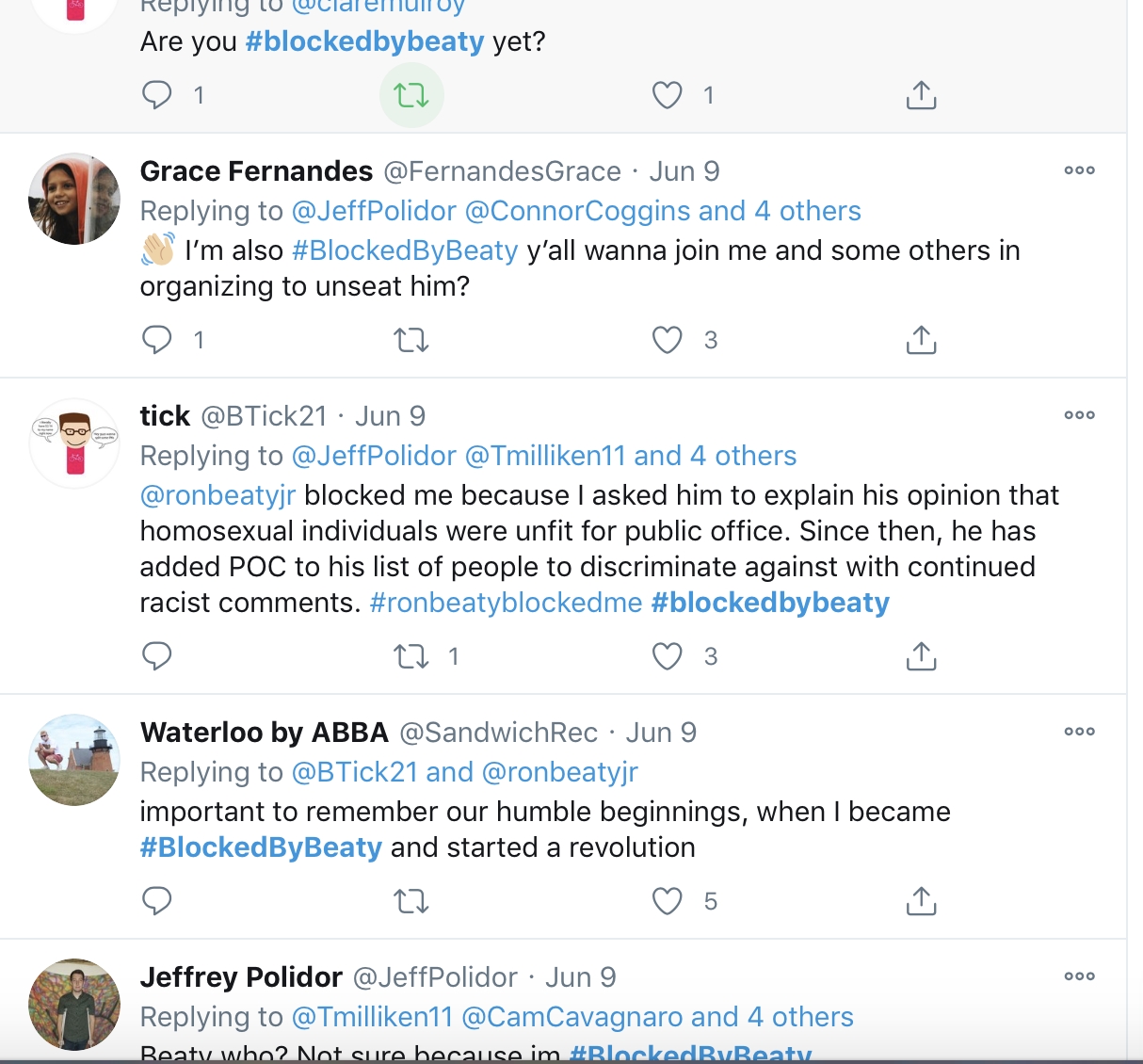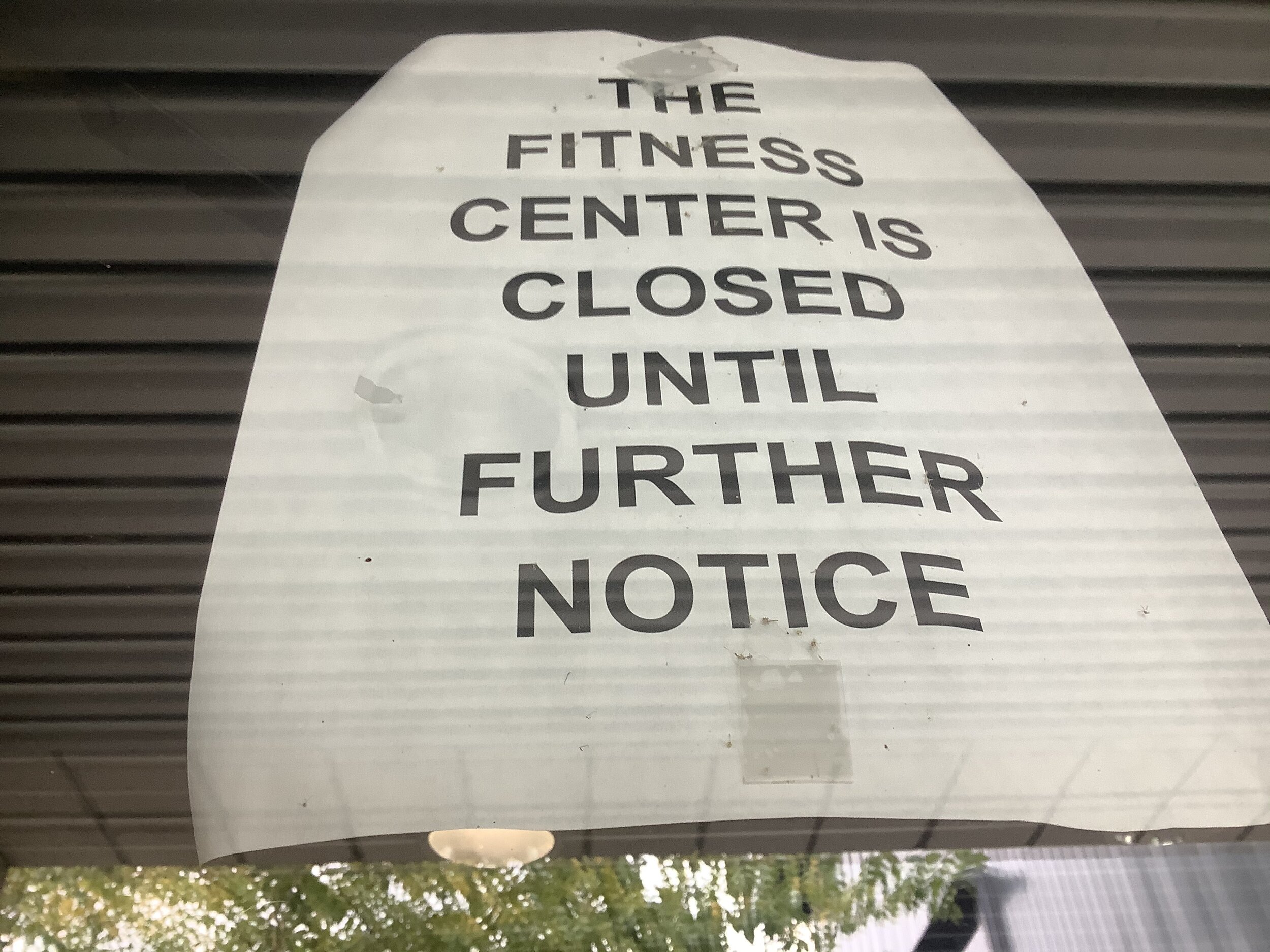Cass Park Rink Provides Socially Distanced Recreation
The entrance to the ice rink, which displays an “Enclose Cass” banner that advocates for turning the rink into a year-round facility. (Jack Murray/Ithaca Week)
BY JACK MURRAY
ITHACA, NY–– For the staff at the Cass Park Rink in Ithaca, New York, seeing community members utilizing the facility is a familiar sight that can help distract from these uncertain times.
The Cass Park Rink, which is owned and operated by the City of Ithaca, is a seasonal ice arena that operates from late October to mid-March. The rink is not fully enclosed. This means that it is technically an outdoor rink, with a light roof that separates the interior from the outside.
Jim D’Alterio, Ithaca Youth Bureau Deputy Director, said the experiences the park had with their summer activities helped his team brainstorm ways to make the winter season work at the rink.
“When the first cases came to Tompkins County last Spring it was during our rink season and we had to close for the last weekend,” D’Alterio said. “That was our first opportunity to look at what we are dealing with. As the summer moved along, we were able to devise some plans and understand that while operating during a pandemic would present challenges, it is a great service for the public at a time when not many things are available.”
When entering the facility, signs dictating how to social distance properly adorn the side boards along with one-way entrances and exits that are meant to keep skaters from bumping into each other. Rink guard Mike Cafaro said that the signs make sure that patrons are made aware of all the new policies that the pandemic called for.
A sign displayed in the bleacher area overlooking the ice rink that describes the facilities policies regarding the pandemic. (Jack Murray/Ithaca Week)
“[The signs] are a necessary reminder that while this may feel like normal fun, and we’re glad that it does feel that way, there is the spectre of the virus that we cannot forget,” Cafaro said. “We can’t be less vigilant or lose focus and having the signs reinforces this.”
As a rink guard, Cafaro is tasked with keeping watch over the public skaters, which includes enforcing masks and social distancing rules. He said that the community has been very cooperative.
“There are times when we have to remind people to keep their distance,” Cafaro said. “Overall, I like how people are able to enjoy normal behaviors but still be able to snap back to reality when needed.”
In addition to public skating, which is held seven days a week and has extended hours on weekends, the rink is home to the Ithaca Youth Hockey Association and also offers skating lessons to beginners.
While hockey is limited currently, as New York State has barred teams from playing any sorts of game-like scenarios, D’Alterio said that the hockey program utilizes the rink seven days a week and is still offering their players practice times.
“We have a whole other set of protocols for hockey use,” D’Alterio said. “They have Covid plans and have adjusted to just doing drills and clinics and people are happy to be able to get out and play in whatever format is available.”
The skating lessons take place throughout the week as well, and D’Alterio said that despite high demand, the rink is not expanding the number of lessons in order to make a full commitment to de-densifying the building.
“We’ve had a lot of requests to open more lessons and we’ve actually had to restrain ourselves,” D’Alterio said. “We try to keep the number of classes relatively low and be happy with what we have got and not push it too much.”
A container of Clorox wipes appear next to the P.A. system, serving as an example of the ice rinks attempt to consistently sanitize all surfaces. (Jack Murray/Ithaca Week)
In order to operate a fully functioning rink with lobbies and locker rooms during a pandemic, D’Alterio said that a commitment to maintaining proper sanitation is very important.
“We have multiple cleaning points throughout the day,” D’Alterio said. “We are spraying down benches frequently and go through the restrooms and cleaning down all commonly touched areas and spraying down rental skates with sanitizer. It’s high frequency and about doing things the best we can to make the whole environment as safe as possible.”
Despite the revised operations at the rink, Cafaro said the positive atmosphere of skaters simply enjoying being on the ice hasn’t changed.
“Everyone is working on their skills, trying to learn new skills or even just trying to get around the ice without falling,” Cafaro said. “They are just enjoying each others company and laughing when they do fall, as we all do.”
Student Activists Stand Strong in 2020 Election
Sandwich High School students stand outside the driveway of Oak Ridge School in East Sandwich, Mass and greet voters as they drive to the polls. (Jack Murray/Ithaca Week)
By Jack Murray
EAST SANDWICH, MA — In February of 2019 Michael Murphy, a student at the University of Massachusetts at Amherst, was blocked by Ron Beaty, the Barnstable County Commissioner, on Twitter. Murphy would soon find out he wasn’t alone in this.
Twitter users who were blocked by Barnstable County Commissioner Ron Beaty connected with each other through the hashtag #BlockedByBeaty (Jack Murray/Ithaca Week)
“I responded to one of his tweets, where he just said some off-the-charts wacky tweet about some marginalized group of people,” Murphy said. “Me being blocked spiraled into the local #blockedbyBeaty movement.”
Murphy, as well as many other young student voters and activists, stayed involved in the 2020 elections in southern Massachusetts despite a global pandemic that made organizing and campaigning more difficult than ever before.
Murphy, who is also enlisted in the Massachusetts Air National Guard, said he and his colleagues turned to social media for information about local and national elections, as well as to help people learn the process of using an absentee ballot.
“It was pretty much known how that there is the potential that it was going to be very difficult to vote in person, or rather it was just going to be not safe to vote in person,” Murphy said. “So it was about spreading information, making sure people knew they could request a mail-in ballot or that the polls were actually going to be open for two weeks prior to actual Election Day.”
Joe Pasquale, another student at UMASS Amherst, has also taken to social media to spread political awareness.
“Social media has become this tool that has more of our awareness, since we're all trapped in the house,” Pasquale said. “Everybody is more of an active participant in this election because it is so heated. Talking about these things in your social circles and thereby sharing it on social media, which is now the extended way we communicate with our social circles in the time of the pandemic is increasingly important because I want to inform my friends of what's actually going on.”
Pasquale said social media allows students to get involved in all forms of political activity while still staying socially distant and safe during the pandemic.
“I mean I wouldn't say really outside of social media that we're doing anything specifically special but this whole election cycle has contributed to all of us just being more politically active and aware in our own mind, our own households, our own social circles and groups,” Pasquale said.
Meanwhile on Election Day, a group of high school students from Sandwich met in-person to make their voices heard, despite not being of age to vote.
Raelyn Mulroy, a student at Sandwich High School, organized a group of her peers at the high school to stand outside Oak Ridge Elementary School and greet voters as they headed to the polls. Mulroy and the other students hoisted up Biden/Harris and Black Lives Matter flags.
Political signs adorn the entranceway to the Oak Ridge School on Nov. 3 (Jack Murray/Ithaca Week)
“I had this idea for a while, and figured there was no better time to do it than now,” Mulroy said. “We sent out a digital poster and spread the word and then built a following.”
Mulroy said that the pandemic influenced students to get involved, as the federal government decisions were impacting their lives.
“Since President Trump hasn’t pushed mask mandates, that affects us greatly,” Mulroy said. “It also affects us because people who impact our lives listen to him over Dr Fauci.”
Even though Mulroy, 17, is ineligible to vote, she said she and her peers possess power in this election.
“We have voices, even though we are not legal adults,” Mulroy said. “There’s not much we can do in changing the legal system, so we have to talk to our parents and other adults in our community and have them help us make change happen.
Murphy said he hopes that young people who were involved with this election will stay engaged with politics, given that they collectively will control the future.
“I do hope that young people, including the college students and the high school students stay involved,” Murphy said. “Those are the most important people because it is their future that is on the ballot, it is their future that is in the hands of the politicians. You lose that control if you never cast a ballot.”
*The opinions expressed within are those only of Mr. Murphy and are in no form expressed opinions or endorsements from the Massachusetts Air National Guard, the United States Air Force, or the DOD.*
Ithaca High School Stadium Upgrades Near Completion
The football field at Ithaca High School’s Moresco Stadium is currently without a finished turf. The Project is expected to be finished completed by Nov. 30. (Photo courtesy of Ithaca City School District.)
By Jack Murray
ITHACA, NEW YORK— When several Ithaca High School athletic teams start their season in March 2021, they will have a newly renovated facility waiting for them.
The school district is in the process of upgrading Moresco Stadium, located at the high school. The renovations include new turf and bleachers, a remodeled track, and the addition of a press box.
The stadium is home to the Little Red football, cheerleading and track and field programs. It also is a host field for girls’ and boys’ lacrosse programs
The original target date for the project to be completed was mid-to-late October 2020, but due to the pandemic that date has shifted to November 30. While in normal circumstances this would be disappointing to fall athletes, the Southern Tier Athletic Conference’s decision to postpone all sports until January at the earliest, allows the contractors to complete the project by the time the athletes step on the field in 2021.
Samantha Little, the Ithaca City School District Athletic Director, said that despite slight delays the Covid-19 pandemic has not affected the renovations process too much, especially since further delay could have led to the harsh winter affecting the building process.
“[The pandemic] allowed them to keep working,” Little said. “We are fortunate that we have people that are able to still work, and our timeline isn’t off that much. You never know what you’re going to get with upstate New York weather, so all of this time during shut down they have been able to really, you know, keep working without interruption.
Little said that the previous turf was just over 10 years old, and the Ithaca community was supportive of the project. Without this support, Little added, the renovations would have been much harder to complete, since the athletic department's budget is less than one percent of the ICSD’s overall budget.
The new press box for the stadium, which will be replacing a structure that had been in place for 60 years. (Jack Murray/Ithaca Week)
“Thankfully, our community is super good to us and voted to have this work done,” Little said. “We couldn't do it without our community and our taxpayers, but it's also a small fraction of where money is being allocated in support of all students and staff in our community. It benefits not just the student athletes but our entire community. It's an instructional space and people really need to start understanding that it's just like the library or a brick-and-mortar classroom.”
The total cost for this project was $2,334,713, as stated in the ICSD’s monthly project status report for September 2020. Little said the project was fully funded by taxpayer money, as the athletic department does not have enough money to fund the project itself.
Little said that in addition to the IHS students, the local community also uses the facility, especially the track, and a semi-professional football team based in Ithaca also utilizes Moresco Stadium.
IHS head football coach Clarence Welch, who also coaches the indoor and outdoor track and field teams, said the renovations will be extremely beneficial to both programs.
“[The facility] gets a lot of use between football and all the fall sports teams and then the spring sports,” Welch said. “Over the years, it’s taken a lot of abuse and it was time for a new surface.”
Welch said that the teams have responded well to the idea of having newly renovated fields and that the effort of investing in students gives them more motivation to work hard and improve.
“It's a confidence builder in athletes that you know someone's investing in their success and their work,” Welch said. “It's fresh, it's new and it is creating a buzz amongst the people that I've talked to.”
The artificial turf and track have not officially been placed yet, but the infrastructure to place them has been prepared. (Jack Murray/Ithaca Week)
Though high school sports could start in January, the earliest the facility will see competition is in March, when the rescheduled fall season is expected to be played. In April, the spring season will start. Welch said the moment the field is used for athletics again will be a moment of relief for the entire community.
“Everything has been taken away from them,” Welch said. “I think once we get on that field it's going to be a big weight off our shoulders and, you know, hopefully exciting things happen on this new stadium.”
Students Work Out Together, While Apart
The entrance to the Ithaca College Fitness Center, where Personal Fitness and Zumba would have been held, hangs a sign announcing the facilities closure. (Jack Murray/Ithaca Week)
BY JACK MURRAY
ITHACA, NEW YORK ––When Ithaca College senior Reisha Grant steps outside of her home in Vermont to go for a run, she is likely joined by several classmates and an instructor who are all doing the same activity in their respective areas.
“Usually I'm not somebody who likes to exercise with other people because I feel like it distracts me,” Grant said. “However, having a class together and running with other people, it actually motivates me more.”
Grant is one of many students who have taken remote physical activities classes at the college since in-person classes were suspended back in March. She is enrolled in a Run, Walk and Jog class that has met synchronously throughout Block I.
The class is offered through the Physical Activity, Leisure and Safety (PALS) department at the college, and the class, along with Personal Fitness, present opportunities for students to continue working out in a group while remote and still earn class credit for them. These classes, which are worth a 0.5 credit, allow for students to fill holes in their schedules.
Becky Robinson, who serves as the head coach of the women’s rowing team at the college, is Grant’s instructor in the Run, Walk and Jog course. She said that the class is structured synchronously so the sense of teamwork that is supposed to be developed through the course can still be retained.
“I think students do not need one more assignment to do on their own time, so having a scheduled time where they have to be somewhere, in workout clothes, is refreshing,” Robinson said.
The class meets on Microsoft Teams and will typically consist of a topic of the day and then will eventually lead to a synchronized workout where all of the participants do the same workout in their individual space. They can track each other through the app Map My Run, which Grant said is another way in which the class feels together.
“Anytime somebody does something physical that they document in the app it alerts me,” Grant said. “There is this type of unity that is making sure we are holding each other accountable to our goals.”
One of the sections of the Personal Fitness class is taught by Maureen Ordnung, who is an assistant coach for the Ithaca College field hockey team. Ordnung said that her class is more focused on giving students guidance on how to work out correctly.
“I speak a little bit about the new topic and ask them a little bit about how familiar they are with the topic,” Ordnung said. “Then I give them some time to turn the videos off, turn the microphones off and then go fill out a template of a workout that they'd like to do.”
The entrance to the Athletics and Events Center, where Run, Walk and Jump would have been held, is darkened in the middle of the day. (Jack Murray/Ithaca Week)
The PALS classes are offered through the registration portal, but are not the only classes being offered. The Ithaca College Fitness Center continued their programming throughout the summer using the Zoom platform. One such class is Zumba, which is taught by graduate student Jaleel Green. Green said that the classes over the summer were a different experience for him as an instructor.
“I like to feed off of the audience, so it was kind of different doing this over Zoom,” Green said. “Some people didn't want to show their camera.”
The Fountain at Dillingham Hall and the Ben Light Gymnasium stand isolated from the students who are studying online. (Jack Murray/Ithaca Week)
Still Green said the opportunity was enjoyed by the participants, who would try to show their cooperation through remarks in the comments section. Green said that the classes are returning shortly and will continue throughout the rest of the semester.
While these opportunities would be preferable in the context of in-person classes, having options for physical activity for students in their remote circumstances have still proven to be beneficial.
“I think the classes are going to be more needed the longer that we stay virtual as they allow students to build in fitness into their daily schedules,” Ordnung said. “Hopefully they leave [the class] being able to program for themselves better.”

